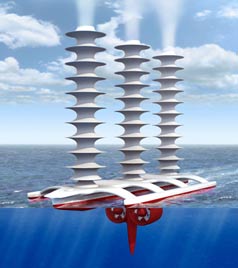1,500 robot ships to prevent Earth warming
An English researcher wants to send hundreds of unmanned ships to the sea to spray water on the air - to curb the warming of the atmosphere.

Fully automatic water sprayer.Picture: John McNeil.
According to the plan of Stephen Salter and colleagues, from University of Edinburgh, they will use hundreds of unmanned robotic boats, passing on the ocean and day and night spraying tiny seawater all year round throughout the month.
In theory, these droplets will be condensed nuclei making the clouds on the ocean white more bright. As a result, they can reflect more sunlight, the heat from the Sun will reach less sea level. Thus, the Earth will generally be less warmed and climate change will stop.
Salter believes that this idea can be a climate saver, especially given the current policy-only policies. "If we don't change the way we live, we need 1200 to 1500 ships , " Salter said. These boats are about 45 meters long and have a displacement of 300 tons.
This idea stands out by surprisingly little cost: Only in the amount of less than 100 million euros annually, including money proving technical feasibility, development costs for mass production and Annual building of new ships.
Take a sailing ship with Magnus effect
The technique of using sprinkler ships is based on the idea of the German inventor Anton Flettner - the Flettner. When a vertical cylinder is rotating and at the same time there is a wind flow, it creates a perpendicular force to the air stream. The reason is the Magnus effect, which is the effect that players apply when they want to kick a ball into the goal.

Old idea: In the 1920s, Anton Flettner, the German inventor, equipped the Flettner rotor for many ships to cross the ocean to the United States.But the plan was unsuccessful in shipping.Photo: Corbis.
In the 1920s Flettner used to have these rotors for many ships, but this transmission was unsuccessful.
It is possible that it will now succeed in the fight against climate change. Salter believes that the Flettner rotor is the most ideal drive technique because it is best suited for computer control. Thus, these unmanned ships will travel on the ocean completely automatically.
In fact, ships with Flettner transmissions are much easier to control than classic sailing boats: There is no need to calculate the position of the sail, but only the speed of rotation of the tube and the position of the rudder is sufficient. To go in the opposite direction, one only needs to change the rotational direction of the Flettner rotor, Mr. Slater explained.
How exactly do these ships work? In the computer model they are three-body ships, the main body in the middle, above the three Flettner rotors. Two secondary bodies create stability. Electrical energy for rotating Flettner rotors and for spraying seawater is caused by a giant propeller under the main body, submerged under water.
"May work"
To achieve the desired effect, every second the vessels must spray 30 kg of seawater carefully filtered into the air. "This method does not create new clouds", it simply makes the clouds white out.
Unmanned ships will operate away from major sea routes, not only in an area but scattered across the oceans. The global operation plan will be controlled by a central computer, the ships will automatically move.
The idea of climate protection ships is supported by many research colleagues. "It will probably work, " said Oliver Wingenter of the New Mexico Mining and Technology Institute. But the problem is that this form of impact on the globe can also make rain less.
Salter also does not deny that unmanned ships could change the climate in the region. "There may be more rain but may also be less. We can decide ahead of time and location of water spraying." The effect of spraying water in any part of the Earth is a significant scientific challenge. According to the current perception, the Arctic in spring is an area for ships to function well, from July to December it is the Pacific Ocean near the coast of North and South America.
However, Salter also knows that this job is risky.
It is possible that ideas like unmanned ships spray water and this will be the last end of the climate. But if the plan does not work as well as it is hoped, at least the beachmen in distress will be glad to have the Flettner ships back and forth across the oceans. Because these three-body ships could be fast lifeboats on the high seas, they automatically advanced to where the ships were in distress. Mr. Salter intends that these sprinklers will carry blankets and drinking water.
- Controversy over the idea of using artificial clouds
- Earth warms weaken El Nino's function to prevent storms
- Fish help prevent warming of the Earth
- Global warming is very urgent
- Earth turns slower because of global warming
- Vessels can cross the Arctic in 2050
- Robots find pirated goods from ships
- Earth warming makes lizards smarter
- Earthworms help slow climate change
- The cause of ice on Earth melted fast
- Scotland faces 'apocalypse' because of global warming
- Posters make us 'startled' about the fate of the Earth
 Is the magnetic North Pole shift dangerous to humanity?
Is the magnetic North Pole shift dangerous to humanity? Washington legalizes the recycling of human bodies into fertilizer
Washington legalizes the recycling of human bodies into fertilizer Lightning stone - the mysterious guest
Lightning stone - the mysterious guest Stunned by the mysterious sunset, strange appearance
Stunned by the mysterious sunset, strange appearance